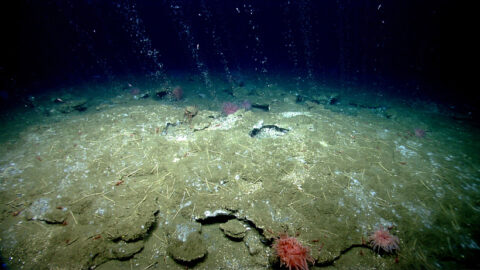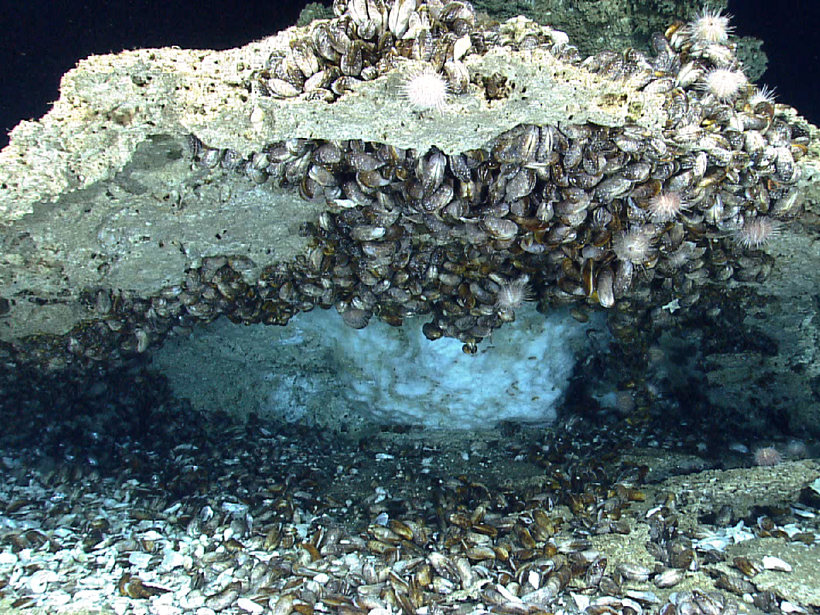One of the fears from global warming is the potential for “tipping points” that will vastly exaggerate the warming, and one of most discussed is increased methane emissions from high latitudes. Methane is a potent greenhouse gas, and large increases in its concentration would certainly amplify the warming associated with anthropogenic emissions. Two potential methane sources have been suggested: melting permafrost on land and subsea permafrost. A review article recently published in Reviews of Geophysics examined the potential for subsea methane hydrates to be a tipping point, but found no evidence so far. The authors, Carolyn D. Ruppel and John D. Kessler, answer some questions about this area of research.
A major concern is that warming in the oceans and the melting of ice might release large amounts of methane stored within ocean sediments which would further amplify the warming. What new understanding or synthesis are you providing of this feedback?
Certainly gas hydrate is breaking down at some locations now, mostly associated with subsea permafrost on Arctic Ocean shelves and with hydrate at the upper limit of its stability on temperate-latitude upper continental slopes affected by warming ocean waters. In our assessment strong biogeochemical sinks and physical processes prevent much of the methane released via gas hydrate degradation from reaching the sea-air interface and being injected into the atmosphere. For example, some of the methane formerly contained in gas hydrate is retained in the sediments and consumed in the near-seafloor sulfate reduction zone in marine settings. Methane bubbles emitted at water depths greater than about 100 m are unlikely to retain their methane as they ascend to the sea-air interface. The methane that dissolves in the water column is often oxidized to carbon dioxide through microbial processes. Seafloor methane emissions are not entirely benign for ocean chemistry, but gas hydrate degradation likely makes insignificant contributions to global atmospheric methane concentrations.
We estimate that seafloor emissions of hydrate-derived methane (most of which never reaches the atmosphere) is dwarfed by annual carbon dioxide emissions to the atmosphere from anthropogenic sources.
What are the societal implications of the new understanding?
Because gas hydrates globally sequester such a large amount of methane at depths that are shallow compared to those associated with conventional gas, even reputable publications sometimes posit that warming climate will lead to catastrophic breakdown of global gas hydrate deposits and the subsequent injection of the released methane into the atmosphere. Our review underscores the implausibility of such scenarios. The spatial distribution of climate-susceptible gas hydrates, the strong sinks that consume much of the methane released from gas hydrate breakdown before the gas reaches the atmosphere, and the thermodynamic barriers to runaway gas hydrate breakdown all argue against strong synergy between gas hydrates and the climate system. In fact, we estimate that seafloor emissions of hydrate-derived methane (most of which never reaches the atmosphere) is dwarfed by annual carbon dioxide emissions to the atmosphere from anthropogenic sources.

What are the major unsolved or unresolved questions and where are additional data or modeling efforts needed?
The most critical need is a fingerprinting method that can distinguish methane formerly contained in gas hydrate from other methane sources. For example, at least 5 geologic sources may contribute to seafloor methane emissions on some Arctic continental shelves, but the scientific community currently lacks the ability to discern the component of emissions that could be derived from degradation of gas hydrate. Another need is for robust measurements of sea-air methane fluxes, particularly at high latitudes where controversy has arisen as various datasets have been reported. Numerical modeling of the interaction of climate and gas hydrates during past warming events and during contemporary and future climate change should also be improved to more thoroughly account for realistic distributions of gas hydrate, sediment and water column methane sinks and the transfer of methane-carbon to other carbon pools, regional oceanographic conditions, and full atmospheric chemistry.
—Alan Robock, Department of Environmental Sciences, Rutgers University; email: [email protected]
Citation:
Robock, A. (2017), Could subsea methane hydrates be a warming “tipping point”?, Eos, 98, https://doi.org/10.1029/2018EO070199. Published on 13 April 2017.
Text © 2017. The authors. CC BY-NC-ND 3.0
Except where otherwise noted, images are subject to copyright. Any reuse without express permission from the copyright owner is prohibited.

